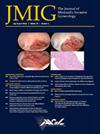Hysteroscopic Treatment of Retained Products of Conception Using See and Treat Operative Office Hysteroscopy Without Anesthesia
IF 3.5
2区 医学
Q1 OBSTETRICS & GYNECOLOGY
引用次数: 0
Abstract
Study Objective
To evaluate clinical efficacy of office operative hysteroscopic treatment of retained products of conception (RPOC) without anesthesia.
Design
A retrospective cohort study.
Setting
A tertiary care academic medical center between April 2019 to March 2023.
Patients
A total of 175 patients with confirmed RPOC underwent see-and-treat operative office hysteroscopy without anesthesia in our outpatient clinic.
Interventions
Hysteroscopic removal of RPOC without anesthesia.
Measurements and Main Results
In 163 cases, the removal of RPOC in the office was attempted, and in 155 cases (95.1%), complete removal of the RPOC without complications was achieved, although it sometimes required a second procedure in clinic. In 12 cases, office operative hysteroscopy was not attempted due to physician decision based on the appearance and vascularity of RPOC, or due to pain during the diagnostic hysteroscopy, or both.
The average size of RPOC for patients treated in the clinic was 15 ± 8.4 mm (range 4–47 mm).
One hundred twenty-eight cases were performed using a Truclear Elite 6 mm device, and 35 cases using a mini-Bettocchi 4.2 mm device. Eighteen cases were unsuccessful on the first attempt; 12 underwent a second procedure in the clinic, which was completed in 10 (83.3%) cases. Of the patients, 105 (71.4%) patients attended a follow-up hysteroscopy, 8 of them (7.6%) required separation of adhesions that were performed in the clinic, and 8 patients were referred to a surgical procedure under anesthesia due to persistent RPOC.
Conclusion
Operative office hysteroscopy is feasible and highly effective for patients with RPOC, with a total success rate of 95.1% complete evacuation in clinic. A follow-up hysteroscopy is important, especially after treatment of large RPOC.
使用无需麻醉的诊室宫腔镜手术治疗滞留的受孕产物。
研究目的评估无需麻醉的宫腔镜手术治疗受孕产物滞留(RPOC)的临床疗效:回顾性队列研究:2019年4月至2023年3月期间,一家三级医疗学术医学中心:共有 175 名确诊 RPOC 患者在我们的门诊诊所接受了不麻醉的诊治性手术宫腔镜检查:干预措施:宫腔镜下RPOC切除术,无需麻醉:在163例病例中,尝试在诊室切除RPOC,其中155例(95.1%)实现了RPOC的完全切除,无并发症,尽管有时需要在门诊进行第二次手术。有12例患者没有尝试在诊室进行宫腔镜手术,原因是医生根据RPOC的外观和血管情况做出了决定,或在诊断性宫腔镜检查时感到疼痛,或两者兼而有之。在诊所接受治疗的患者的 RPOC 平均大小为 15± 8.4 毫米(范围为 4-47毫米)。其中 128 例使用 Truclear Elite 6 毫米装置,35 例使用迷你贝托奇 4.2 毫米装置。18 例患者第一次手术失败,12 例患者在诊所接受了第二次手术,其中 10 例(83.3%)完成了手术。105例(71.4%)患者接受了后续宫腔镜检查,其中8例(7.6%)需要在诊所进行粘连分离,8例患者因RPOC持续存在而被转诊至麻醉下的外科手术:结论:诊室宫腔镜手术对 RPOC 患者是可行且高效的,在诊室完全排空的总成功率为 95.1%。尤其是在治疗大面积RPOC后,进行后续宫腔镜检查非常重要。
本文章由计算机程序翻译,如有差异,请以英文原文为准。
求助全文
约1分钟内获得全文
求助全文
来源期刊
CiteScore
5.00
自引率
7.30%
发文量
272
审稿时长
37 days
期刊介绍:
The Journal of Minimally Invasive Gynecology, formerly titled The Journal of the American Association of Gynecologic Laparoscopists, is an international clinical forum for the exchange and dissemination of ideas, findings and techniques relevant to gynecologic endoscopy and other minimally invasive procedures. The Journal, which presents research, clinical opinions and case reports from the brightest minds in gynecologic surgery, is an authoritative source informing practicing physicians of the latest, cutting-edge developments occurring in this emerging field.

 求助内容:
求助内容: 应助结果提醒方式:
应助结果提醒方式:


